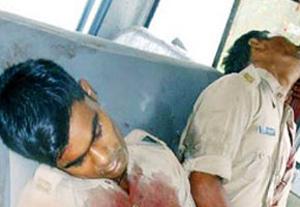 Kolkata, Jul 3: Armed Maoists killed Amarjit Balihar, Superintendent of Police (SP) of Pakur, his driver and three other policemen escorting his vehicle in an ambush on Tuesday at Kathikund, 36 kilometres from Dumka in Jharkhand.
Kolkata, Jul 3: Armed Maoists killed Amarjit Balihar, Superintendent of Police (SP) of Pakur, his driver and three other policemen escorting his vehicle in an ambush on Tuesday at Kathikund, 36 kilometres from Dumka in Jharkhand.
The three other cops, who sustained grievous injuries, were rushed to Sadar Hospital where one of them died, taking the toll to six.
The incident took place when the SP was returning to Pakur from Dumka after attending a meeting convened by Dumka DIG Priya Dubey. Sources told Deccan Herald over the phone that around 4 pm, the Maoists fired nearly a hundred rounds at the SP and his team who were caught unawares in the dense forest area between Pakur and Dumka.
Balihar, 45, who was promoted as an IPS officer in 2003, and his team could not get enough time to retaliate.
Senior Jharkhand Police officers are concerned that as neighbouring West Bengal is in the process of heightening security after announcing its panchayat poll schedule, there could be a large scale movement by Maoist squads, sources said.
According to sources, Pakur was one district in Jharkhand that has been relatively free of Maoist influence, with sporadic incidents of violence. “Since Pakur is just around 15-20 km from Rampurhat in the Birbhum district of West Bengal, the Left extremists kept it somewhat peaceful to ensure safe passage across the state lines,” said a senior officer from West Bengal Police's anti-terrorist cell.
The sources added that Amrapara and Paturia are the only two police stations under Pakur, which had seen Maoist violence when earlier this year two security guards of Panel coal mine in Paturia were killed by the Left extremists.
The Jharkhand administration set up a camp for an Indian Reserve Battalion at Paturia after the killings at Panel mine.The operation was led by Lalesh Yadav, the Maoist area commander of Latehar region, said the sources.
Since Jharkhand is under President’s rule, Governor Syed Ahmad took stock of the situation and asked the DGP and the home secretary to rush to the incident site.
“We have launched a massive combing operation to flush out the Maoists from the forest area,” said Priya Dubey, who was the first IPS officer to reach the place of incident.
This is the first major Maoist attack in the Santhal Parganas region of Jharkhand, which comprises mostly poor tribals. But in south Jharkhand, the Maoists had earlier created havoc when they killed CPI-ML legislator Mahendra Singh at Giridih in 2005, followed by the killing of Jharkhand Mukti Morcha MP from Jamshedpur Sunil Mahto in 2007.
The same year, the Maoists also gunned down son of former chief minister of Jharkhand Babulal Marandi at Giridih, which shares a long jungle border with Bihar.





Comments
Add new comment